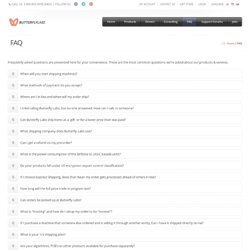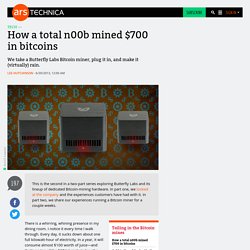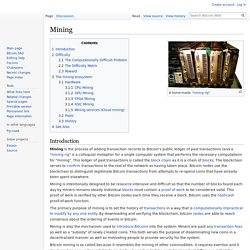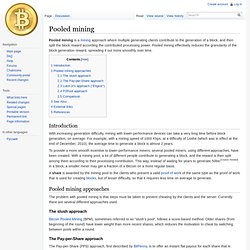

Mining Bitcoins takes power, but is it an “environmental disaster?” Mark Gimein is something of a Bitcoin skeptic, but in addition to his concerns about Bitcoin not being a "real currency," he's now charging that it has created "a real-world environmental disaster.

" Writing in Bloomberg News, Gimein notes that mining Bitcoins—performing the computationally expensive calculations needed to define new Bitcoins—uses power. Beginners Guide to Mining Bitcoins. Last updated on December 18th, 2017 at 06:06 pm One of the biggest problems I ran into when I was looking to start mining Bitcoin for investment and profit was most of the sites were written for the advanced user.

I am not a professional coder, I have no experience with Ubuntu, Linux and minimal experience with Mac. So, this is for the individual or group that wants to get started the easy way. 1. Butterfly Labs. MiniRig SC : $650 per month, per rig 50 GH/s , 60 GH/s $90 per month, per unit Your hosted units will be added to a mining farm and you will be paid out regularly based on their collective output.

Currently, the payout is approximately every two days, depending on luck. As difficulty increases, payout times may get longer or the payout threshold may be reduced to bring it back to every 2 days or so. If you wish to have direct control over your units, you may provide a laptop or netbook computer (or one can be sourced locally at cost). Additionally, if you have more units than the provided computer has USB ports, you will need to provide enough USB hubs to support your equipment. Your equipment will be housed in one of three data centers in the Kansas City area (With a 4th coming online in the next 6 months). Luke-jr/bfgminer. See What Bitcoin Mining Really Looks Like. We’ve got a Butterfly Labs Bitcoin miner, and it’s pretty darn fast.
Apparently, I'm a Bitcoin miner now, and it looks like I'm actually pretty good at it.

Ars is currently in possession of one of the elusive but very real Butterfly Labs Bitcoin Miners. It's a tiny little black box that fits in the palm of my hand, and it contains a specialized ASIC adept at chewing through SHA-256 cryptographic functions—exactly the kind of calculations necessary to bring more Bitcoins into the world. Turns out, it's very good at what it does: it computes hashes at the rate of about 5.3 billion per second. I've got any number of computers around the house here to try the Butterfly Labs box out with, but I took the masochistic route and chose to try it out on OS X. These 7 Bitcoin-mining rigs show how far some people will go for virtual money. In a mad quest to amass some dicey digital money, some people are building computer rigs so ridiculous they could literally burn a house down.

Bitcoin mining is the process through which the untraceable crypto-currency, popular in the darker corners of the Web, is generated through complex mathematical problems that maintain the network's public logbook of transactions. The logbook is called the block chain, and without it, Bitcoin users would not be able to accurately tell whether their coin is legitimate or if it's been spent twice.
Miners are automatically awarded 25 bitcoins for every block of mathematical problems solved—a figure determined by the Bitcoin community that will decrease as more blocks are mined. The mathematical problems are self-regulating and "only get harder as miners throw more and more collective computing power at them," Gizmodo reported. Want to make money off Bitcoin mining? Hint: Don't mine. Digital Drills: The Monster Machines that Mine Bitcoin.
Explorateur de blocs Bitcoin - Blockchain.info. WalletBuy & Sell Crypto ExchangeProfessional Trading ExplorerLive Data, Charts & Transactions Crypto Prices. The Cryptography of Bitcoin. It is actually surprisingly difficult for a layperson to find out precisely what cryptography Bitcoin uses, without consulting the source of Bitcoin directly.

For example, the opcode OP_CHECKSIG , ostensibly checks the signature of something... but there is no indication what kind of signature it checks! (What are opcodes in Bitcoin? Well it turns out that the protocol has a really neat scripting system built in for building transactions. You can read more about it here. ) So in fact, I managed to get some factual details wrong on my post Bitcoin is not decentralized , which I realized when commenter cruzer claimed that a break in the cryptographic hash would only reduce mining difficulty, and not allow fake transactions.
So I did my research and cracked open the Bitcoin client source code. How a total n00b mined $700 in bitcoins. This is the second in a two-part series exploring Butterfly Labs and its lineup of dedicated Bitcoin-mining hardware.

In part one, we looked at the company and the experiences customers have had with it.
Mining Hardware. Bitcoin Mining in Plain English. Beginners Guide to Mining Bitcoins. Mining. Introduction.

Pooled mining. Pooled mining is a mining approach where multiple generating clients contribute to the generation of a block, and then split the block reward according the contributed processing power.

Pooled mining effectively reduces the granularity of the block generation reward, spreading it out more smoothly over time. Introduction With increasing generation difficulty, mining with lower-performance devices can take a very long time before block generation, on average. For example, with a mining speed of 1000 Khps, at a difficulty of 14484 (which was in effect at the end of December, 2010), the average time to generate a block is almost 2 years.
To provide a more smooth incentive to lower-performance miners, several pooled miners, using different approaches, have been created. Comparison of mining pools. Reward types & explanation: CPPSRB - Capped Pay Per Share with Recent Backpay. [1] DGM - Double Geometric Method.

A hybrid between PPLNS and Geometric reward types that enables to operator to absorb some of the variance risk. Operator receives portion of payout on short rounds and returns it on longer rounds to normalize payments. [2] ESMPPS - Equalized Shared Maximum Pay Per Share. Like SMPPS, but equalizes payments fairly among all those who are owed. [3] POT - Pay On Target. A high variance PPS variant that pays on the difficulty of work returned to pool rather than the difficulty of work served by pool [4] PPLNS - Pay Per Last N Shares. Payout Methods. Difficulty. See also: target. Bitcoin network graphs. A Guide to Bitcoin Mining: Why Someone Bought a $1,500 Bitcoin Miner on eBay for $20,600. With the price of bitcoins skyrocketing, mining is suddenly big business, so enticingly big that one wannabe miner was willing to pay a 1,333 percent premium to get his (or her) foot in the door of this wildly lucrative bitcoin bonanza.
Ladies and gentlemen, welcome to the bitcoin gold rush. The craziest part? This wasn’t an auction for a physical, working, ready-to-ship bitcoin mining machine from Avalon, which claims to be the first to develop turnkey, bitcoin-specific mining computers for sale. For $20,600 (bidding started at a reasonable $500), the lucky winner only received a place in line and the promise that an actual (pre-ordered) miner will be delivered sometime next month.
If that sounds ridiculous, well, it’s because it quite possibly is. Merged Mining - Namecoin DNS. From Namecoin DNS This page has not yet been migrated to the new wiki but it may have been partially moved or simply out of date. Instead of editing this page, please take a moment and help move it to the new wiki. This page is also in need of a rewrite :/ Tell me how it works in easy words! "Merged mining works like this, you have two totally separate block chains, they are not related in any way nor does either contain any data from the other.